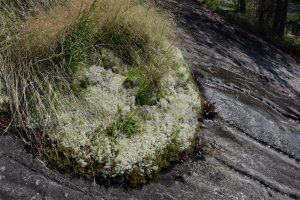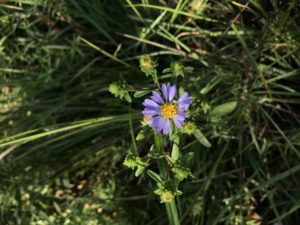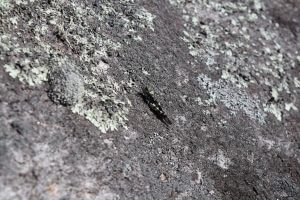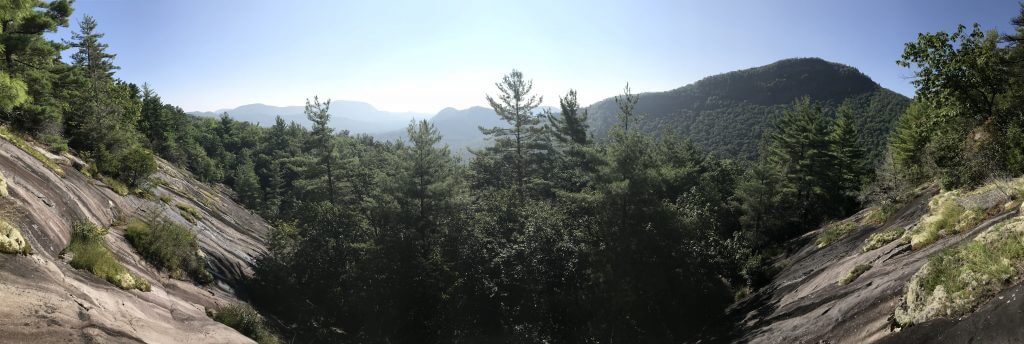This article was originally published the Transylvania Times and is reprinted here with permission of the author – Owen Carson, Botanist at Equinox.
Formed many millions of years ago, the mountains of western North Carolina are home to numerous unique geologic formations, from the rocky summits of Grandfather Mountain to the serpentine barrens of Buck Creek. These complex aboveground forms that remain are stark reminder of the subterranean processes that originally shaped our landscape. On a local scale, Transylvania, Jackson, and Macon Counties (amongst others) boast a handful of these geologic wonders, namely the unique high elevation granitic domes that are exemplified by sites such as Looking Glass Rock, Cedar Rock, Laurel Knob, Whitesides, and The Fodderstacks. These granitic upwellings, known as plutons, rise sharply above the surrounding land, their sheer cliff faces and crystalline crests shining bright on a sunny day. And although a bare, exposed rock face might seem like an inhospitable environment, the amount of flora and fauna that finds a way to survive is truly remarkable. 
While the margins of a granitic dome are generally wooded, the rock itself is sparse with vegetation at a glance. However, peer closer and you’ll find a diverse and complex array of plants interacting around the limited resources that can be found on the dome. Moss mats are the primary component interacting with the rock face – these mats originate as small clusters of moss and lichen that have taken hold in depressions or crevices in the granite. The clusters become anchors for larger clumps, which in turn begin to support larger, more diverse flora. As the anchoring plants become smothered and die, they start to form soil; this soil will eventually allow grasses, wildflowers, and even woody plants to flourish! Sadly the mats are impermanent, in constant cyclical succession, and when heavy rains pour down the steep pitches of the dome mats can be loosened and scoured from the wall, sloughing downhill and leaving bare rock behind for the process to begin anew.
limited resources that can be found on the dome. Moss mats are the primary component interacting with the rock face – these mats originate as small clusters of moss and lichen that have taken hold in depressions or crevices in the granite. The clusters become anchors for larger clumps, which in turn begin to support larger, more diverse flora. As the anchoring plants become smothered and die, they start to form soil; this soil will eventually allow grasses, wildflowers, and even woody plants to flourish! Sadly the mats are impermanent, in constant cyclical succession, and when heavy rains pour down the steep pitches of the dome mats can be loosened and scoured from the wall, sloughing downhill and leaving bare rock behind for the process to begin anew.
 High elevation granitic domes are globally imperiled ecosystems – there simply aren’t many that exist. The rarity of the environment is reflected in the diversity of plants and animals that have specifically adapted for life in such a harsh place – state and federally protected plants such as, granite dome bluet, Blue Ridge ragwort, granite dome St. John’s wort, and endemic plants like mountain dandelion, granite dome goldenrod, and pinkshell azalea, all thrive in the exposed habitat where there is little competition from larger trees and shrubs. Some areas can look almost like grasslands – Biltmore sedge, artic reedgrass, deerhair bulrush, and several species of oatgrass create a swaying sea in late summer. Other areas that are influenced by perennial seepage can form spray cliff habitats that offer real estate for several species of filmy ferns and other unique nonvascular plants. The domes at the highest elevations, which experience extreme temperature, wind, and solar exposure, also provide refugia for plants such as dwarf juniper and bigtooth aspen that are adapted to thrive in more northern, boreal climates, and are therefore quite rare in our state. Exposed, north-facing cliffs can also support populations of endangered rock gnome lichen.
High elevation granitic domes are globally imperiled ecosystems – there simply aren’t many that exist. The rarity of the environment is reflected in the diversity of plants and animals that have specifically adapted for life in such a harsh place – state and federally protected plants such as, granite dome bluet, Blue Ridge ragwort, granite dome St. John’s wort, and endemic plants like mountain dandelion, granite dome goldenrod, and pinkshell azalea, all thrive in the exposed habitat where there is little competition from larger trees and shrubs. Some areas can look almost like grasslands – Biltmore sedge, artic reedgrass, deerhair bulrush, and several species of oatgrass create a swaying sea in late summer. Other areas that are influenced by perennial seepage can form spray cliff habitats that offer real estate for several species of filmy ferns and other unique nonvascular plants. The domes at the highest elevations, which experience extreme temperature, wind, and solar exposure, also provide refugia for plants such as dwarf juniper and bigtooth aspen that are adapted to thrive in more northern, boreal climates, and are therefore quite rare in our state. Exposed, north-facing cliffs can also support populations of endangered rock gnome lichen.
Let’s not forget the critters that eke out an existence on the granite, however diminutive they may be. Woodrats, shrews, and voles may nest in adjacent woodlands, but can be observed scurrying about the  exposed rock, foraging for fruits, nuts, and seeds. But It’s so exposed out there that you’d better have good camouflage – the lichen mimic grasshopper is a perfect example of an insect that is perfectly adapted, its patterning nothing short of incredible. Green salamanders sport a similar suit, their flecking helping to blend them into the crevices they occupy. The exposed nature of the rock faces and the resulting daily thermal flux is attractive to snakes and lizards trying to bask – timber rattlesnakes, copperheads, fence lizards, and skinks alike, find suitable shelter in lateral crevices along the face and talus piles at the base. Furthermore, the federally endangered peregrine falcon can be found nesting in fractures within the steepest pitches of granitic domes; there’s nothing quite like seeing them plummet at breakneck speeds in pursuit of a meal.
exposed rock, foraging for fruits, nuts, and seeds. But It’s so exposed out there that you’d better have good camouflage – the lichen mimic grasshopper is a perfect example of an insect that is perfectly adapted, its patterning nothing short of incredible. Green salamanders sport a similar suit, their flecking helping to blend them into the crevices they occupy. The exposed nature of the rock faces and the resulting daily thermal flux is attractive to snakes and lizards trying to bask – timber rattlesnakes, copperheads, fence lizards, and skinks alike, find suitable shelter in lateral crevices along the face and talus piles at the base. Furthermore, the federally endangered peregrine falcon can be found nesting in fractures within the steepest pitches of granitic domes; there’s nothing quite like seeing them plummet at breakneck speeds in pursuit of a meal.
These habitats are easily damaged by trampling, modification, or outright conversion, thus protection of high elevation granitic domes is a top priority for conservation organizations in the region, And despite many of the domes occurring on forest service land, local land trusts have worked hard to permanently protect and steward most of the remainder that falls on lands under private ownership. Land management is protective of rare elements – seasonal restrictions have been established where recreation interfaces with these habitats in order to protect resources during critical periods. Certain areas where peregrines are known to roost are closed off to climbers during nesting season; barricades and signage have been placed to discourage pedestrian access atop certain domes containing high concentrations of rare plants. Education is arguably one of the most critical components of conservation, and there are ample resources available to learn about granitic domes, the most tangible of which are real-world experiences afforded by hiking to the top of one of the dozen plutons in the area. Seeing (and smelling) granite dome goldenrod glowing in full flower in late August, or stalking a lichen mimic grasshopper for a half-hour just to snap the perfect image – those are the types of visceral experiences that solidify the significance of these elements and their containing environment. Created primordially, shaped by time, and untouched by the hand of man until contemporary times, these ancient granite habitats will forever remain a unique and important component of our mountains to be experienced and cherished. 
